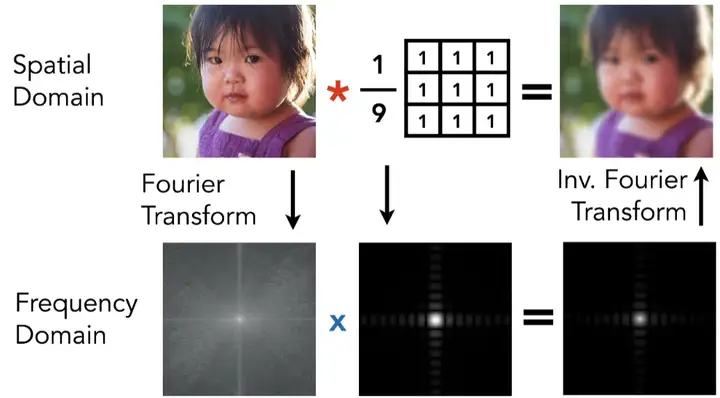5.0 KiB
5.0 KiB
title, date, excerpt, tags, rating
| title | date | excerpt | tags | rating |
|---|---|---|---|---|
| ToonPostProcess | 2024-05-15 16:50:13 | ⭐ |
Bloom
Bloom主要分
- Bloom
- FFTBloom
- LensFlares
FFTBloom
普通Bloom算法只能做到圆形光斑,对于自定义形状的就需要使用FFTBloom。
频域与卷积定理
图像可以视为二维的信号,而一个信号可以通过 不同频率 的 Sine & Cosine 函数的线性叠加来近似得到。对于每个频率的函数,我们乘以一个常数振幅并叠加到最终的结果上,这些振幅叫做 频谱。值得注意的是所有的 F_k 都是 复数:
 此时频域上的每个振幅不再代表某个单个的时域样本,而是代表该频段的 Sine & Cosine 函数对时域信号的 整体 贡献。频域信号包含了输入图像的全部时域信息,**因此卷积定理告诉我们在时域上对信号做卷积,等同于将源图像与滤波盒图像在频域上的频谱(上图系数 V_k)做简单复数 乘法:
此时频域上的每个振幅不再代表某个单个的时域样本,而是代表该频段的 Sine & Cosine 函数对时域信号的 整体 贡献。频域信号包含了输入图像的全部时域信息,**因此卷积定理告诉我们在时域上对信号做卷积,等同于将源图像与滤波盒图像在频域上的频谱(上图系数 V_k)做简单复数 乘法:
 一一对位的乘法速度是远远快于需要循环累加的朴素卷积操作。因此接下来我们的目标就是找到一种方法,建立图像信号与其频域之间的联系。在通信领域通常使用傅里叶变换来进行信号的频、时域转换
一一对位的乘法速度是远远快于需要循环累加的朴素卷积操作。因此接下来我们的目标就是找到一种方法,建立图像信号与其频域之间的联系。在通信领域通常使用傅里叶变换来进行信号的频、时域转换
相关代码
FBloomFindKernelCenterCS:用于找到Bloom效果的核(Kernel)中心(纹理中找到最亮的像素)。用于在一个,并记录其位置。主要通过计算Luminance来获取到中心区域,而在这里的中心区域可以有多个,这也代表着在最终输出的SceneColor里可以有多个【曝点光晕(Bloom)效果】
实用代码
代码位于DeferredShadingCommon.ush:
// @param UV - UV space in the GBuffer textures (BufferSize resolution)
FGBufferData GetGBufferData(float2 UV, bool bGetNormalizedNormal = true)
{
#if GBUFFER_REFACTOR
return DecodeGBufferDataUV(UV,bGetNormalizedNormal);
#else
float4 GBufferA = Texture2DSampleLevel(SceneTexturesStruct.GBufferATexture, SceneTexturesStruct_GBufferATextureSampler, UV, 0);
float4 GBufferB = Texture2DSampleLevel(SceneTexturesStruct.GBufferBTexture, SceneTexturesStruct_GBufferBTextureSampler, UV, 0);
float4 GBufferC = Texture2DSampleLevel(SceneTexturesStruct.GBufferCTexture, SceneTexturesStruct_GBufferCTextureSampler, UV, 0);
float4 GBufferD = Texture2DSampleLevel(SceneTexturesStruct.GBufferDTexture, SceneTexturesStruct_GBufferDTextureSampler, UV, 0);
float CustomNativeDepth = Texture2DSampleLevel(SceneTexturesStruct.CustomDepthTexture, SceneTexturesStruct_CustomDepthTextureSampler, UV, 0).r;
// BufferToSceneTextureScale is necessary when translucent materials are rendered in a render target
// that has a different resolution than the scene color textures, e.g. r.SeparateTranslucencyScreenPercentage < 100.
int2 IntUV = (int2)trunc(UV * View.BufferSizeAndInvSize.xy * View.BufferToSceneTextureScale.xy);
uint CustomStencil = SceneTexturesStruct.CustomStencilTexture.Load(int3(IntUV, 0)) STENCIL_COMPONENT_SWIZZLE;
#if ALLOW_STATIC_LIGHTING
float4 GBufferE = Texture2DSampleLevel(SceneTexturesStruct.GBufferETexture, SceneTexturesStruct_GBufferETextureSampler, UV, 0);
#else
float4 GBufferE = 1;
#endif
float4 GBufferF = Texture2DSampleLevel(SceneTexturesStruct.GBufferFTexture, SceneTexturesStruct_GBufferFTextureSampler, UV, 0);
#if WRITES_VELOCITY_TO_GBUFFER
float4 GBufferVelocity = Texture2DSampleLevel(SceneTexturesStruct.GBufferVelocityTexture, SceneTexturesStruct_GBufferVelocityTextureSampler, UV, 0);
#else
float4 GBufferVelocity = 0;
#endif
float SceneDepth = CalcSceneDepth(UV);
return DecodeGBufferData(GBufferA, GBufferB, GBufferC, GBufferD, GBufferE, GBufferF, GBufferVelocity, CustomNativeDepth, CustomStencil, SceneDepth, bGetNormalizedNormal, CheckerFromSceneColorUV(UV));
#endif
}
// Minimal path for just the lighting model, used to branch around unlit pixels (skybox)
uint GetShadingModelId(float2 UV)
{
return DecodeShadingModelId(Texture2DSampleLevel(SceneTexturesStruct.GBufferBTexture, SceneTexturesStruct_GBufferBTextureSampler, UV, 0).a);
}
ShadingModel判断
bool IsToonShadingModel(float2 UV)
{
uint ShadingModel = DecodeShadingModelId(Texture2DSampleLevel(SceneTexturesStruct.GBufferBTexture, SceneTexturesStruct_GBufferBTextureSampler, UV, 0).a);
return ShadingModel == SHADINGMODELID_TOONSTANDARD
|| ShadingModel == SHADINGMODELID_PREINTEGRATED_SKIN;
}
PS.需要Shader添加FSceneTextureShaderParameters/FSceneTextureUniformParameters。
IMPLEMENT_STATIC_UNIFORM_BUFFER_STRUCT(FSceneTextureUniformParameters, "SceneTexturesStruct", SceneTextures);
BEGIN_SHADER_PARAMETER_STRUCT(FSceneTextureShaderParameters, ENGINE_API)
SHADER_PARAMETER_RDG_UNIFORM_BUFFER(FSceneTextureUniformParameters, SceneTextures)
SHADER_PARAMETER_RDG_UNIFORM_BUFFER(FMobileSceneTextureUniformParameters, MobileSceneTextures)
END_SHADER_PARAMETER_STRUCT()